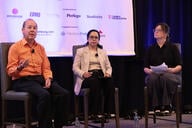You have /5 articles left.
Sign up for a free account or log in.

Istockphoto.com/useng
When Nancy Coleman started in her role as associate provost and director of strategic growth initiatives at Wellesley College two and a half years ago, she quickly realized that she had an uphill battle ahead of her.
Administrators there wanted to tap in to new sources of revenue amid rising maintenance costs to revitalize the college's aging buildings. Undergraduate enrollment had been steady, Coleman said, but other markets remain untapped.
But with no existing online programs and a culture unaccustomed to rapid transformation, they weren’t prepared for the challenge, Coleman admitted during a session last month at the University Professional, Continuing and Online Education Association’s annual meeting.
“Wellesley had no understanding of this market,” Coleman said. “I’m not really sure that they had a full understanding of what this could be or what they wanted it to be.”
Her job has been to fill in the gaps. The college currently offers one course online, with more to follow; Coleman also oversees professional and executive education as well as summer and precollege programs. During the UPCEA session, she and several colleagues at other institutions shared experiences that will be relevant to anyone at an institution trying to move into online or other markets for the first time.
The three institutions represented on the panel -- Old Dominion University in Virginia, Marquette University in Wisconsin, and Wellesley -- lack the brand recognition of nationwide online leaders like Western Governors and Southern New Hampshire Universities, and the substantial resources of many publicly funded state institutions.
James Shaeffer, founding dean of Old Dominion’s College of Continuing Education and Professional Development, said funding for his continuing education initiatives isn’t reliable.
“In terms of being able to roll dollars over, it really depended how the institution did at the end of the year,” Shaeffer said. “If they didn’t need the dollars, we were able to roll them over. Sometimes not so much.”
More From “Inside Digital Learning”
How a small environmental college in Maine carved out an online niche.
Institutions increasingly experiment with the length of online courses.
State and university systems plan major online growth.
Schaefer arrived at Old Dominion three years ago from James Madison University. His charge was to bring together six or seven existing continuing education units on campus to eliminate redundancies and cultivate a more coherent strategy. He did so successfully, but the unit fell short of revenue expectations and has since been downsized, with staff members outsourced back to academic departments.
The story at Marquette, meanwhile, was familiar: flattening on-ground enrollment and looming incremental costs, according to David Schejbal, who started at Marquette last August as vice president and chief of digital learning after 11 years as dean of continuing education, outreach and e-learning at the University of Wisconsin Extension, which focuses heavily on adult and online learners.
Like the others, Schejbal has had to adjust to a budget model less forgiving than the one afforded him at his previous employer. Marquette has a zero-based budget that doesn’t roll over from year to year and a negligible history of revenue sharing within the institution.
Lessons Learned
Ensure that senior leaders are supportive and that they communicate their support. Coleman said she struggled at first because people who worked in various departments at Wellesley immediately looked down on her as the “money lady,” rather than someone tasked by university leadership to thoughtfully create new initiatives.
Deans will be reluctant to collaborate on new initiatives if they don’t sense support from top leaders at the institution, according to Schejbal.
“I think it’s incumbent on leadership to say, ‘This is a campus priority -- here’s how we move forward,’” Schejbal said. “If leadership washes its hands of that, that’s their failure.”
Align each part of the institution with the overall mission. Seven or eight years ago, when Coleman worked at Boston University, online students with billing problems called the university’s financial services office, only to be told, “We don’t have online students here.”
Each university culture is different, but all could benefit from some shaking up to meet student demands, according to Coleman. For instance, universities that allow administrators to take off Fridays in the summer could be putting students who expect 24-7 services in a bind. “They’re used to the Amazon experience,” she said.
One audience member during the UPCEA session said she’s had success on her campus with a “talking tour” to educate numerous offices about the basics of the institution’s online and continuing education offerings.
“When they get that weird phone call, they at least know it exists,” she said. “They still may not be able to tell the student anything about it, but they can say that it’s familiar.”
Think bigger. Schejbal was initially tasked with growing Marquette’s online programs, but the scope has since widened to include hybrid and part-time programs, in an effort to serve a diverse adult population. He said he’s also now considering partnering with external companies for the early growth portion of Marquette’s online efforts.
Old Dominion is currently working on establishing apprenticeship programs that relate to four-year degrees, Shaeffer said. He recently sat down with local community college leaders and shipbuilding industry representatives about the possibility of offering “pre-skills skills” programs at Old Dominion that prepare students for intensive shipbuilding training.
Don’t get too comfortable. A year into Shaeffer’s time at Old Dominion, the provost who championed his mission left the institution. Meanwhile, his budget consisted of his salary and little else.
At Wellesley, Coleman said she works constantly to establish a “sub-brand” within the institution that honors the institution’s reputation for high-quality undergraduate education.
“I’ve spent more time at networking meetings and lunches and dinners than I ever want to see,” Coleman said. “But it’s working.”




